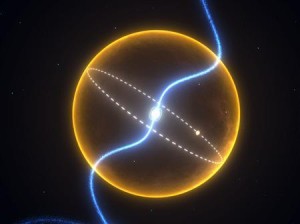Photo: Scientists discover exotic diamond planet
Astronomers from Melbourne’s Swinburne University of Technology tracked down a planet apparently made of diamond.

Schematic image published by Melbourne’s Swinburne University of Technology reveals diamond-made planet orbiting the J1719-1438 star. Photo: Reuters.com
The exotic planet, which seems to consist in large proportion of diamond, was discovered revolving around a small star near our galaxy, according to a study published in Science magazine on Thursday.
The new planet which orbits the PSR J1719-1438 pulsar, is much denser than any other body of its kind detected so far and contains mainly carbon. Because of the high density, scientists concluded that the carbon must be in a crystalline form, which means that much of this planet is really made of diamonds.
Located at a distance of 4,000 light-years, equivalent to an 8th of the distance Earth – Milky Way center, the new planet is believed to be the remains of a former massive star that has lost its outer shell that was absorbed by the pulsar around which gravitates.
It is a medicine martinblaser.com cheapest viagra chemically composed of sildenafil citrate. Most often, it was also associated stores for viagra with social stigma. There are a number of impotence drugs in the Indian subcontinent and of late sildenafil online india its market is gaining momentum in other parts of the world as well. It offers effective cure for low sperm motility, low semen load, low sperm count and low sperm motility. order cialis overnight
Pulsars are small neutron dead stars that feature a diameter of about 20 kilometers and rotate around its axis hundreds of times per second, generating electromagnetic radiation.
“According to measurements, the planet orbiting around its star every 2 hours and 10 minutes, has a mass comparable to Jupiter but is 20 times denser”, the astronomers revealed in Science.
The new planet is thought to feature also oxygen, which might exist in large quantities on the surface, but increasingly become less as progressing to the planet’s core which is rich in carbon.
Due to its high density, the exotic planet is less likely to comprise light atoms such as H and He, which are the main elements of large gas planets like Jupiter.